
Classic Buses Profiles
Thames Valley Bristol Ls (by Dick Gilbert)
Last updated 22 July 2022

SOME LINKS WITHIN THIS WEBSITE:
Home
Email
Links
THE COMPLETE WEBSITE MENU
Events Diary
Halfcab list
Small-Ads
Classic Irish Buses
Classic Manx Buses
Another look at some delightful vehicles from the past. Here we pay a visit to Thames Valley and
remember some of their Bristol single deckers from the 1940s and 1950s.
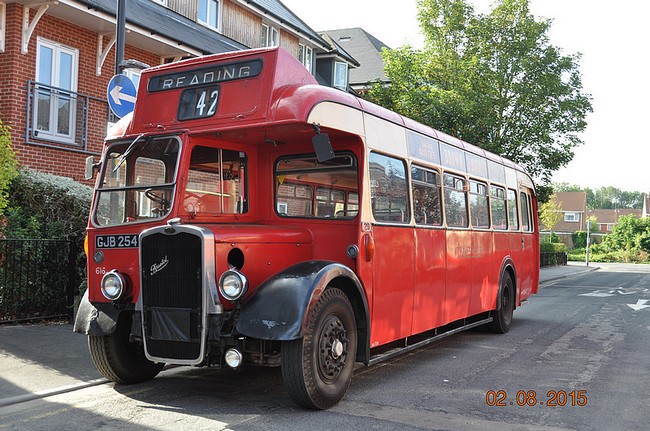
Preserved no. 616 at the Thames Valley 100th event, Reading in August 2015. Photo by kind
permission of Ken Jones.
Thames Valley Traction Company can trace its origins to 1915, although it only became a fully-fledged
and independent operation from July 1920. It was controlled by the Tilling Group from 1935, and operated services to and from
Reading, Bracknell, Maidenhead, Newbury, Wycombe, Oxford and surrounding areas.
A varied pre-war fleet was standardised towards Bristol products from the 1940s onwards, although the
acquisition of a host of smaller local operators added some non-standard vehicles at times. Among the Bristol single deckers were
many LS-type vehicles, and also a variety of full-fronted machines, some of which arrived with the absorption of South Midland
Motor Services in 1950. However, LSs are not included in this review.
Many moved on to other work after retirement, and details are shown below when known. Among their
varied duties, one wound up being operated by Rev. Ian Paisley in Northern Ireland.
The chassis and engine manufacturer Bristol named each new model with a consecutive alphabetical
letter. Thus, the K double decker of the mid-1930s was followed by its single-deck equivalent, the L. Bristol Ls with Eastern
Coachworks (ECW) bodies were built in huge numbers and served all over Britain. At first glance they all appeared absolutely
identical, but there were in fact several versions with visible differences.
The basic L was launched in 1937, and reappeared after the war in 1946 as an improved model. It had a
16 ft. 2 inch wheelbase and was 7 ft. 6 inches wide. In 1950 a longer version was introduced with a 19 ft. long wheelbase,
increasing the capacity of the bus by one seat row - i.e. 4 seats. This typically meant an increase from 35 seats to 39, and the
model was named the LL (for L Long). In 1951 an 8 ft wide version became available, and this was known as the LW (for L Wide). An
example that was both long and wide was designated the LWL.
The designation also showed the number of cylinders and the manufacturer of the engine. So, an LWL6B
was a Bristol L, 8 feet wide, with a lengthened wheelbase, and a 6-cylinder Bristol engine. Whereas an LL5G was a Bristol L, with a
long wheelbase (but only 7 ft 6 inches wide) and a 5-cylinder Gardner engine.
Six of the vehicles reviewed here have survived to the present day, including some outstanding
restorations. A visitor would be quite likely to see one at any summer bus rally west of London.
As for Thames Valley, it eventually came under the control of the National Bus Company, and was
amalgamated with Aldershot and District in 1972. The new operation was daftly christened Alder Valley, a title which did not
correspond to any place to be found on the map! In the 1980s the combine collapsed and was sold off.
As with any list, the odd mistake is bound to creep in, and some relevant information may be missing
so, in order to make it as accurate a reference as possible, I would of course welcome any additions or corrections.
My sincere thanks to Mac Head, Phil Cross and Nigel Lemon, who have provided a wealth of new
information, correcting much of the original data and supplying me with details of many vehicles I had no idea existed. Most of all,
I owe a debt to the late Eric Sieler who was a great enthusiast for all things Thames Valley (and also Southern Vectis). When he
sadly passed away in 2017 his wife generously donated his extensive collection - including hundreds of photographs - to the Classic
Buses Website, and many of his pictures appear on this page.
FLEET LIST
BRISTOL L6A - 455 - 459 (total 5)
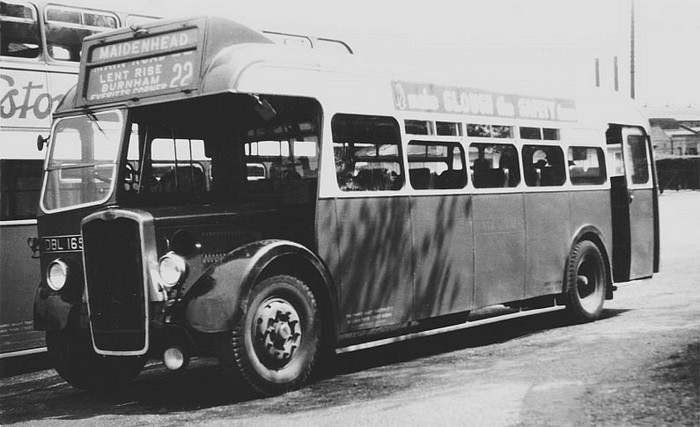
Thames Valley 457 (DBL 165). Photo from the collection of the late Eric Sieler.
Built in 1947.
Chassis: Bristol L6A with 6-cylinder AEC-built oil engines.
Body: Eastern Coach Works (ECW) B35R.
- 455 (DBL 163) c/n 61.066. Withdrawn July 1958 and sold to Passenger Vehicle Disposals, Woolston Grange, Rugby. Then to T. D. Alexander (Greyhound), Sheffield Dec 1958 as no. 70, used for steelworks staff transport.
- 456 (DBL 164) c/n 61.085. Withdrawn 1958. Sold Jan 1959 Fleet Car Sales, Dunchurch, Rugby, then to Gee, Walker and Slater (contractors), Derby in Jun 1961 as no. 62.
- 457 (DBL 165) c/n 61.086. Withdrawn July 1958 and sold to Passenger Vehicle Disposals, Woolston Grange, Rugby. Sold again July 1958 to Crouch (contractor), Birtley. Still with them in 1960.
- 458 (DBL 166) c/n 61.103. Withdrawn July 1958 and sold to Passenger Vehicle Disposals, Woolston Grange, Rugby. Then to T. D. Alexander (Greyhound), Sheffield Dec 1958 as no. 72, used for steelworks staff transport.
- 459 (DBL 167) c/n 63.026. Withdrawn Dec 1958 and sold to Passenger Vehicle Disposals, Woolston Grange, Rugby. Then to Crouch (contractor), Birtley (still with them in 1962).
BRISTOL L6B - 460 - 465 (later 794-799) (total 6)
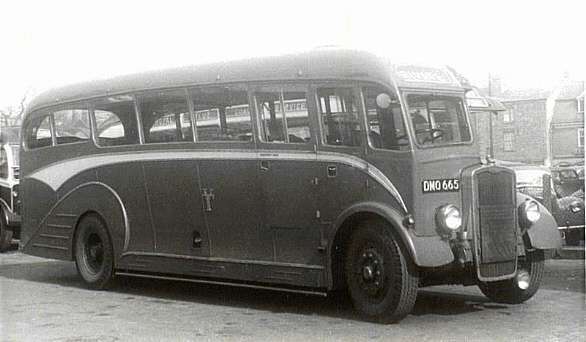
Vincent-bodied no. 461 (DMO 665) on a private hire in the early 1950s, before conversion to bus
configuration. Photo: unknown.
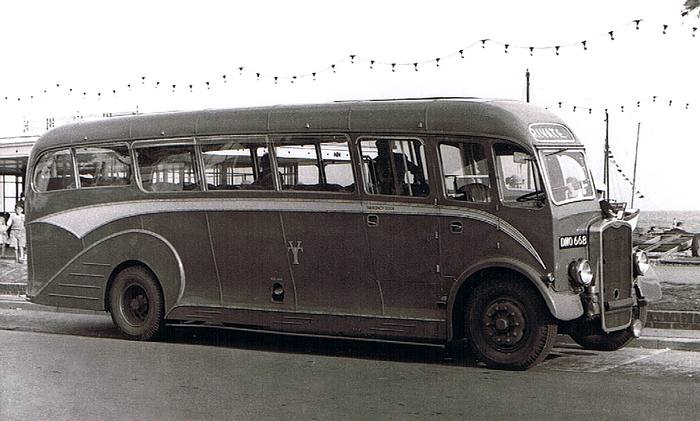
No. 464 (DMO 668) seen on a private hire to a coastal resort in the 1950s also has a Vincent body.
Photo from the Roy Marshall collection via the East Pennine transport group.
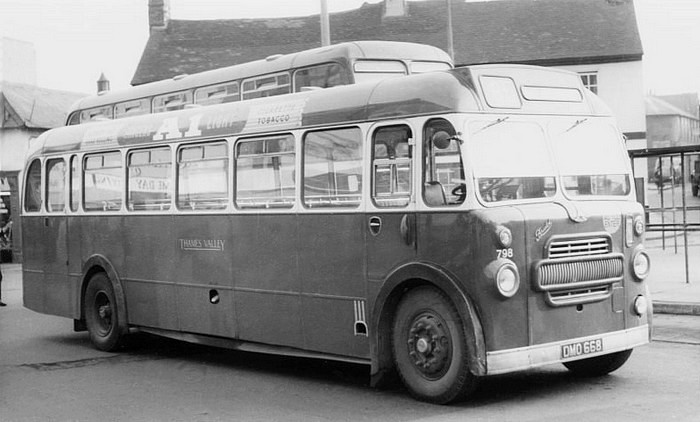
DMO 668 renumbered as no. 798 after acquiring its full-fronted ECW bus body in 1958. Photo from the
collection of the late Eric Sieler.
Built in 1947-48 (Windover-bodied vehicles entered service in 1947, Vincent bodies in 1948).
Chassis: Bristol L6B with 6-cylinder 8-litre Bristol oil engines. All rebuilt and lengthened to 30
feet in 1958 as Bristol LL5G with 5-cylinder Gardner engines, and renumbered.
Body: Windover Huntingdon or Vincent front entrance 32-seat coach bodies, painted cream with green
mudguards and radiators. All rebuilt to 30 feet in 1958 with ECW FB39F pay as you enter bodies, and renumbered.
- 460 (DMO 664) c/n 63.127, deliv.9/47. Windover Huntingdon {6663} C32F, then to LL5G ECW FB39F (OMO) in 1958, renumbered 794. Withdrawn 1967.
- 461 (DMO 665) c/n 63.149, deliv.1948. Vincent C32F, then to LL5G ECW FB39F (OMO) in Sept 1957, renumbered 795. Withdrawn 1967 and sold to Imperial (Moore), Windsor.
- 462 (DMO 666) c/n 63.178, deliv.9/47. Windover Huntingdon {6664} C32F, then to LL5G ECW FB39F (OMO) in 1958, renumbered 796. Withdrawn 1967 and sold to Blanch, Lely, (agricultural services) Crudwell, Wilts.
- 463 (DMO 667) c/n 63.179, deliv.10/47. Windover Huntingdon {6665} C32F, then to LL5G ECW FB39F (OMO) in 1958, renumbered 797. Withdrawn 1967 and sold to Percy Trentham (contractor).
- 464 (DMO 668) c/n 63.165, deliv.1948. Vincent C32F, then to LL5G ECW FB39F (OMO) in 1958, renumbered 798. Withdrawn 1967 and sold to Imperial (Moore), Windsor.
- 465 (DMO 669) c/n 65.018, deliv.10/47. Windover Huntingdon {6666} C32F, then to LL5G ECW FB39F (OMO) in 1958, renumbered 799. Withdrawn 1967 and sold to Imperial (Moore), Windsor.
BRISTOL L6A - 472 - 486 (total 15)
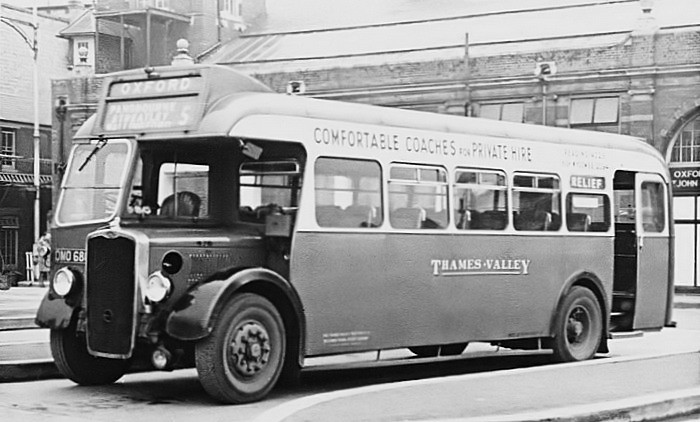
Thames Valley 476 (DMO 680) is, I think, seen at Oxford Railway Station. Photo from the collection
of the late Eric Sieler.
Built in 1948 (Note: 472-477 were delivered in 1947, but did not enter service until Jan 1948).
Chassis: Bristol L6A with 6-cylinder AEC-built oil engines.
Body: Originally ECW B35R bodies (although some had 31 semi-luxury seats), but all converted in 1950
to dual-purpose DP35R configuration.
- 472 (DMO 676) c/n 65.198. Withdrawn 1958, and sold Jul 1958 to Passenger Vehicle Disposals, Dunchurch, Rugby. To T. D. Alexander Greyhound), Sheffield in Dec 1958 as no. 74.
- 473 (DMO 677) c/n 65.199. Withdrawn 1958 and sold to Passenger Vehicle Disposals, Woolston Grange, Rugby. To Jordan, Blaenavon Jun 1959. Engine out by May 1962.
- 474 (DMO 678) c/n 67.020. Withdrawn 1958, and sold Jul 1958 to Passenger Vehicle Disposals, Woolston Grange, Rugby. To T. D. Alexander (Greyhound), Sheffield in Dec 1958 as no. 68.
- 475 (DMO 679) c/n 67.021. Withdrawn 1958 and sold to Passenger Vehicle Disposals (dealers) Dunchurch, Rugby. To Gee, Walker and Slater (contractors), Derby, by 1960.
- 476 (DMO 680) c/n 67.063. Withdrawn 1958, and sold Jul 1958 to Passenger Vehicle Disposals, Dunchurch, Rugby. To T. D. Alexander (Greyhound), Sheffield in Dec 1958 as no. 67.
- 477 (DMO 681) c/n 67.064. Withdrawn 1958, and sold Jul 1958 to Passenger Vehicle Disposals, Dunchurch, Rugby. To T. D. Alexander (Greyhound), Sheffield in Dec 1958 as no. 71.
- 478 (DMO 682) c/n 67.079. Withdrawn 1958 and sold to Passenger Vehicle Disposals, Dunchurch, Rugby. To Jordan, Blaenavon Apr 1959.
- 479 (DMO 683) c/n 67.080. Withdrawn 1958 and sold to Passenger Vehicle Disposals, Dunchurch, Rugby. To Derek Crouch (contractor), Newcastle Aug 1960.
- 480 (DMO 684) c/n 67.081. Withdrawn 1958 and sold Jan 1959 to Fleet Car Sales, Dunchurch, Rugby. To Jordan, Blaenavon Jun 1959. Still with them May 1962, but engine out.
- 481 (DMO 685) c/n 67.093. Withdrawn 1958 and sold to Passenger Vehicle Disposals, Dunchurch, Rugby. Then to Scarlet Band Motor Services, West Cornforth, Co.Durham Aug 1958 as no. 41. To F. Cowley (dealer), Salford Mar 1960.
- 482 (DMO 686) c/n 67.094. Withdrawn 1958, and sold Jul 1958 to Passenger Vehicle Disposals, Dunchurch, Rugby. To T. D. Alexander (Greyhound), Sheffield in Dec 1958 as no. 60.
- 483 (DMO 687) c/n 67.109. Withdrawn 1958, and sold Jul 1958 to Passenger Vehicle Disposals, Dunchurch, Rugby. To T. D. Alexander (Greyhound), Sheffield in Dec 1958 as no. 74. With C. Davies, Pontlottyn by Jul 1962.
- 484 (DMO 688) c/n 67.110. Withdrawn 1958, and sold Jul 1958 to Passenger Vehicle Disposals, Dunchurch, Rugby. To T. D. Alexander (Greyhound), Sheffield in Dec 1958 as no. 58.
- 485 (DMO 689) c/n 67.163. Withdrawn 1958, and sold Jul 1958 to Passenger Vehicle Disposals, Dunchurch, Rugby. To T. D. Alexander (Greyhound), Sheffield in Dec 1958 as no. 56, used for steelworks staff transport.
- 486 (DMO 690) c/n 67.164. Withdrawn 1958, and sold Jul 1958 to Passenger Vehicle Disposals, Dunchurch, Rugby. To T. D. Alexander (Greyhound), Sheffield in Dec 1958 as no. 57.
BRISTOL L6B - 487 - 491 (total 5)
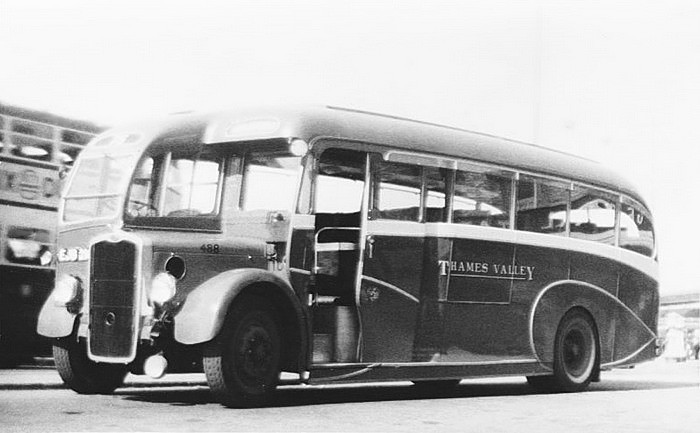
Thames Valley 488 (EJB 210). Photo from the collection of the late Eric Sieler.
Built in September 1948.
Chassis: Bristol L6B with 6-cylinder Bristol AVW oil engines.
Body: Windover Huntingdon C32F.
Notes: All withdrawn and sold in 1957.
- 487 (EJB 209) c/n 67.188, b/n 6839. Deliv.9/48. Withdrawn 1957 and sold Sept 1957 to A. E. Connerton (dealers), Brixton. To Cabin Coaches, Staines Oct 1957, to Young, Grays, Essex, Mar 1958.
- 488 (EJB 210) c/n 67.189, b/n 6840. Deliv.9/48. Withdrawn 1957 and sold Sept 1957 to A. E. Connerton (dealers), Brixton. To Thurgood (dealer), Ware Oct 1957. To Young, Grays, Essex, Jan 1958 (as an L5G).
- 489 (EJB 211) c/n 67.190, b/n 6841. Deliv.9/48. Withdrawn 1957 and sold Sept 1957 to A. E. Connerton (dealers), Brixton. To Elms Coaches, Kenton May 1958, to Goddard, Davidson & Smith (dealers), Putney Bridge Sept 1959. With Eastbourne Coachways, Eastbourne by Jun 1962, but out of use. Later to Cheek, Kenton, but withdrawn around 1965.
- 490 (EJB 212) c/n 67.191, b/n 6842. Deliv.9/48. Withdrawn 1957 and sold Sept 1957 to A. E. Connerton (dealers), Brixton. Sold again Sept 1961 to Taylor, London SE1. Still there May 1960 but sold by 1961.
- 491 (EJB 213) c/n 67.192, b/n 6843. Deliv.9/48. Withdrawn 1957 and sold Sept 1957 to A. E. Connerton (dealers), Brixton. To Thurgood (dealer), Ware Oct 1957. To Young, Grays, Essex, Feb 1958 (as an L5G). To Goddard, Davidson and Smith (dealers), Putney Bridge Sept 1959.
BRISTOL L6B - 521 - 523 (total 3)
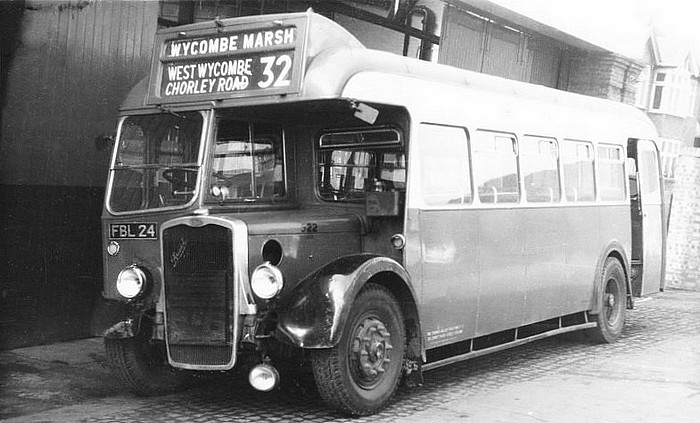
Thames Valley 522 (FBL 24). Photo from the collection of the late Eric Sieler.
Built in 1949.
Chassis: Bristol L6B with 6-cylinder Bristol AVW oil engines.
Body: Eastern Coach Works (ECW) rear entrance 35-seat bus bodies.
- 521 (FBL 23) c/n 73037. Withdrawn 1959 and sold Nov 1959 to Fleet Cars Sales, Dunchurch, Rugby. Then to Cyril Davies, Pontllottyn (still with them in 1962).
- 522 (FBL 24) c/n 73036. Withdrawn 1959 and sold Nov 1959 to Fleet Car Sales, Dunchurch, Rugby. Then to Jounce (or Johnsey?), Newport, Mon. Feb 1960. Out of use and stored 1961-62, parked on waste land at Lunar Sept 1962.
- 523 (FBL 25) c/n 73058. Withdrawn 1960 and sold Nov 1959 to Fleet Car Sales, Dunchurch, Rugby. To Jordan, Blaenavon Apr 1960.
BRISTOL L6B - 534 - 544 (total 11)
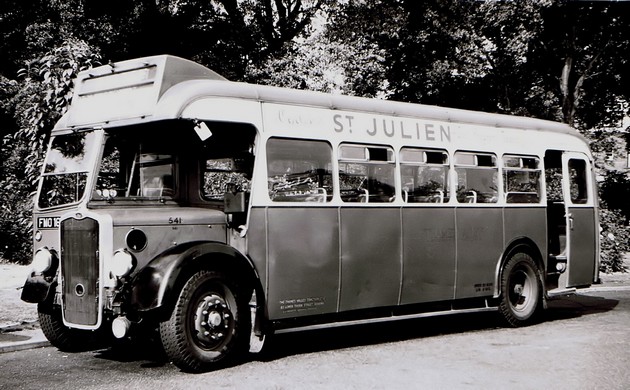
No. 541 (FMO 16) on relief duties on the 1950s. Photo: unknown.
Built 1949-50
Chassis: Bristol L6B with 6-cylinder 8-litre Bristol AVW oil engines.
Body: Eastern Coach Works (ECW) 35-seat bus bodies with rear entrances, painted red with cream lining.
Notes: All were sold to United Welsh in 1960, retaining their Thames Valley fleet numbers with the
new owner.
- 534 (FMO 9) c/n 73059, built 1949. ECW B35R body. Sold to United Welsh as no. 534 in 1960. With Sir Lindsay Parkinson and Co., London (contractor) as staff bus in Southend area 1986.
- 535 (FMO 10) c/n 73092, built 1949. ECW B35R body. Sold to United Welsh as no. 535 in 1960.
- 536 (FMO 11) c/n 73093, built 1949. ECW B35R body. Sold to United Welsh as no. 536 in 1960.
- 537 (FMO 12) c/n 73113, built 1949. ECW B35R body. Sold to United Welsh as no. 537 in 1960.
- 538 (FMO 13) c/n 79027, built 1950. ECW B35R body. Sold to United Welsh as no. 538 in 1960.
- 539 (FMO 14) c/n 79057, built 1950. ECW B35R body. Appears in the 1960 film Snowball about a boy (Dennis Waterman) allegedly turned off a bus because he didn't have a ticket. Filmed mostly at Independent Artists Studios at Beaconsfield, Bucks. Sold to United Welsh as no. 539 in 1960.
- 540 (FMO 15) c/n 79118, built 1950. ECW B35R body. Sold to United Welsh as no. 540 in 1960.
- 541 (FMO 16) c/n 79119, built 1950. ECW B35R body. Sold to United Welsh as no. 541 in 1960. To West of England Transport Collection, Winkleigh, but later broken up.
- 542 (FMO 17) c/n 79147, built 1950. ECW B35R body. Sold to United Welsh as no. 542 in 1960.
- 543 (FMO 18) c/n 79148, built 1950. ECW B35R body. Sold to United Welsh as no. 543 in 1960.
- 544 (FMO 19) c/n 79149, built 1950. ECW B35R body. Sold to United Welsh as no. 544 in 1960.
BRISTOL L6B - 545 - 555 (total 11)
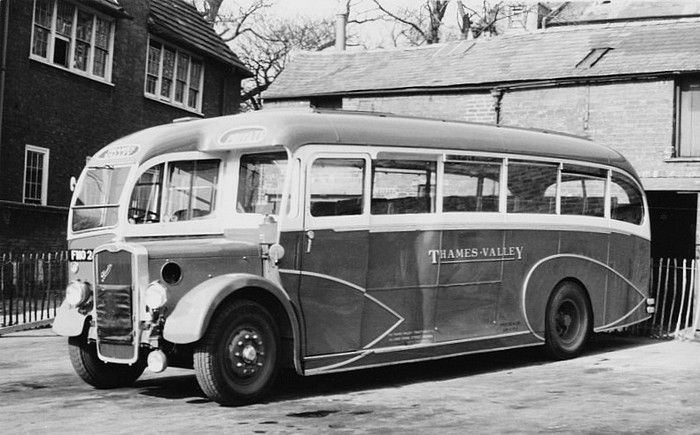
I think this is Thames Valley 549 (FMO 24) with its Windover Huntingdon coach body in the early
1950s, before conversion to bus configuration. Photo from the collection of the late Eric Sieler.
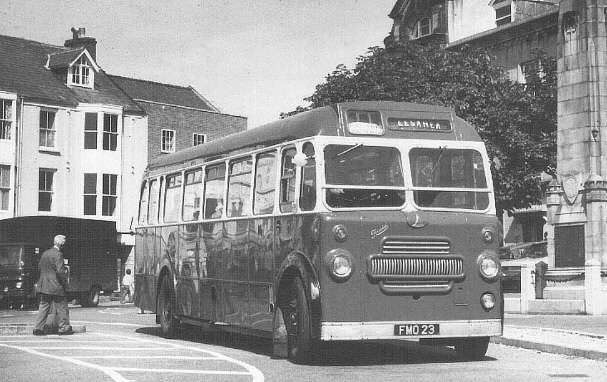
John Bristow of Swansea, a former native of High Wycombe, kindly sent this photo. He says: I
thought that you would like the attached shot of the rebodied FMO 23 in service with Express Motors at Caernarfon. I took the photo
on 20 August 1968.
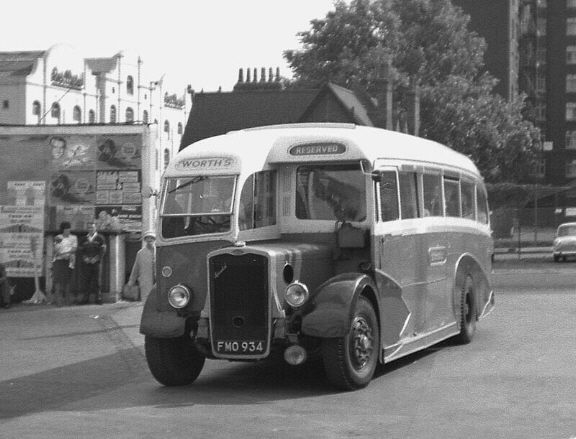
This fine photo kindly sent by Ray Soper shows FMO 934 working for Worth's of Enstone in the 1960s.
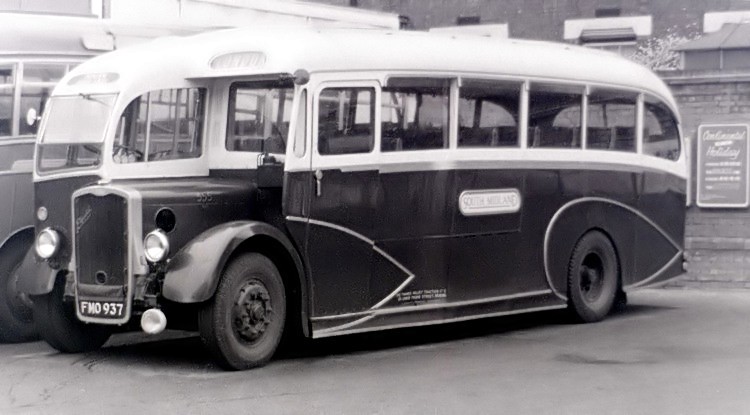
FMO 937 in South Midland livery at Victoria Coach Station in 1959, waiting for a late afternoon
departure to Oxford. Photo by Robert Blackshaw.
Built in 1950.
Chassis: Bristol L6B with 6-cylinder Bristol AVW oil engines. Four (546-549) were later converted
to LL5G buses (30 ft. long, with Gardner 5LW engines and full-front bodies) in 1958 and renumbered as 817-820.
Body: Windover Huntingdon C33F. Four (546-549) were later given ECW FB39F bodies in 1958 and
renumbered as 817-820.
- 545 (FMO 20) c/n 79058, deliv.3/50. Windover Huntingdon {6844} C33F. Transferred to the subsidiary South Midland fleet. Withdrawn 1961. Noted at Passenger Vehicle Disposals, Dunchurch 19 Feb 1961.
- 546 (FMO 21) c/n 79089, deliv.3/50. Windover Huntingdon {6845} C33F. Converted to LL5G and rebodied as ECW FB39F in 1958, and renumbered as 817. Withdrawn 1968.
- 547 (FMO 22) c/n 79090, deliv.3/50. Windover Huntingdon {6846} C33F. Converted to LL5G and rebodied as ECW FB39F in 1958, and renumbered as 818. Withdrawn 1968 and sold to Rossmore BC, Sandbanks.
- 548 (FMO 23) c/n 79116, deliv.3/50. Windover Huntingdon {6857} C33F. Converted to LL5G and rebodied as ECW FB39F in 1958, and renumbered as 819. Withdrawn 1968 and sold to Express Motors, Rhostryfan.
- 549 (FMO 24) c/n 79117, deliv.3/50. Windover Huntingdon {6858} C33F. Converted to LL5G and rebodied as ECW FB39F in 1958, and renumbered as 820. Withdrawn 1968 and sold to Golden Miller, Feltham.
- 550 (FMO 25) c/n 81068, deliv.7/50. Windover Huntingdon {6906} C33F. Withdrawn 1961 and sold to Cosy, Meadowfield.
- 551 (FMO 26) c/n 81069, deliv.7/50. Windover Huntingdon {6907} C33F. Withdrawn 1961 and sold to Cosy, Meadowfield.
- 552 (FMO 934) c/n 81070, deliv.7/50. Windover Huntingdon {6908} C33F. Withdrawn 1961 and sold to Worth, Enstone.
- 553 (FMO 935) c/n 81071, deliv.7/50. Windover Huntingdon {6909} C33F. Withdrawn 1961. Noted at Passenger Vehicle Disposals, Dunchurch 19 Feb 1961. Sold to S. Davies, Cardiff.
- 554 (FMO 936) c/n 81072, deliv.7/50. Windover Huntingdon {6910} C33F. Withdrawn 1961 and sold to Jordan, Blaenavon.
- 555 (FMO 937) c/n 81120, deliv.7/50. Windover Huntingdon {6911} C33F. Transferred to the subsidiary South Midland fleet. Withdrawn 1962 and sold to Creamline, Bordon.
BRISTOL LL6B - 556 - 576 (total 21)
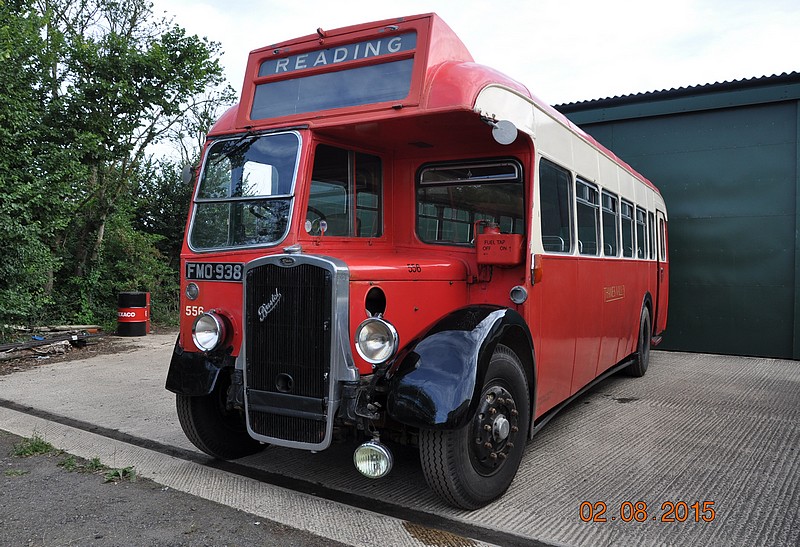
Preserved no. 556 (FMO 938) at the Thames Valley 100th event in Reading, August 2015. Photo by kind
permission of Ken Jones.

Thames Valley 561 (FMO 943). Photo from the collection of the late Eric Sieler.
Built 1950-51. Nos. 556-563 were built and delivered in 1950, nos. 564-569 were delivered in 1950 but
did not enter service until 1951 and nos. 570-576 were built and delivered in 1951.
Chassis: Bristol LL6B with 6-cylinder 8-litre Bristol AVW oil engines.
Body: All Eastern Coach Works (ECW) 30 feet long, 7 feet 6 inches wide B39R bodies. Numbers 564-568
were rebuilt by ECW in 1958 to one man operated (OMO) configuration with front entrances and angled nearside cab windows for fare
collection.
Notes: Eleven of this batch were sold to United Welsh in 1960-61, retaining their Thames Valley fleet numbers with the new owner.
- 556 (FMO 938) c/n 81121, b/n 4711, deliv.1950. Served at Reading, then Newbury. Sold to United Welsh as their no. 556 in Sept 1960, then to Prescelly of Clynderwen in 1966, then to Jones of Login for school work (1970s). ** SURVIVOR ** Graham Tyler, Warndon, nr. Worcester. To Thames Valley and Great Western omnibus trust 9/20. Full bodywork restoration completed 2021, still undergoing interior and seating work.
- 557 (FMO 939) c/n 81122, deliv.1950. Sold to United Welsh 1961. With Tudor Williams, Laugharne in 1966.
- 558 (FMO 940) c/n 81123, deliv.1950. Sold to United Welsh 1960 as their no. 558.
- 559 (FMO 941) c/n 81124, deliv.1950. Withdrawn 1967
- 560 (FMO 942) c/n 83093, deliv.1950. Withdrawn 1968 and sold to Elm Park Coaches, Romford. To Cedric Coaches, Wivenhoe, Essex in 1969 to carry Terson staff on British Railways maintenance contract duties.
- 561 (FMO 943) c/n 83094, deliv.1950. Sold to United Welsh 1960
- 562 (FMO 944) c/n 83095, deliv.1950. Sold to United Welsh 1961
- 563 (FMO 945) c/n 83096, deliv.1950. Sold to United Welsh 1961
- 564 (FMO 946) c/n 83097, deliv.1950. Front entrance o. m. o. rebuild in 1958. Withdrawn 1967. To Elm Park Coaches, Romford. Picture here. With Continental Pioneer, Richmond in 1968 with fleetname Pioneer Coaches, used on Richmond Stn. to Richmond Hill service.
- 565 (FMO 947) c/n 83128, deliv.1951. Front entrance o. m. o. rebuild in 1958. Withdrawn 1968 and sold to Alexander (Greyhound).
- 566 (FMO 948) c/n 83129, deliv.1951. Front entrance o. m. o. rebuild in 1958. Withdrawn 1968.
- 567 (FMO 949) c/n 83130, b/n 4722, deliv.1951. Front entrance o. m. o. rebuild in 1958. Withdrawn 1968 and sold to Alexander (Greyhound), Arbroath (via Sheffield). ** SURVIVOR ** Richard Rampton, Reading 2004.
- 568 (FMO 950) c/n 83173, deliv.1951. Front entrance o. m. o. rebuild in 1958. Withdrawn 1968 and sold to Alexander (Greyhound), Arbroath (via Sheffield).
- 569 (FMO 951) c/n 83174, deliv.1951. Withdrawn 1968 and sold to Alexander (Greyhound).
- 570 (FMO 952) c/n 83175, deliv.1951. Sold to United Welsh 1962
- 571 (FMO 953) c/n 83176, deliv.1951. Noted at Passenger Vehicle Disposals, Dunchurch 19 Feb 1961. Sold to Alexander (Greyhound), Sheffield around 1968.
- 572 (FMO 954) c/n 83177, deliv.1951. Sold to United Welsh 1961
- 573 (FMO 955) c/n 83190, deliv.1951. Sold to United Welsh 1962
- 574 (FMO 956) c/n 83191, deliv.1951. Withdrawn 1968 and sold to Alexander (Greyhound), Sheffield.
- 575 (FMO 957) c/n 83192, deliv.1951. Sold to United Welsh 1962
- 576 (FMO 958) c/n 83193, deliv.1951. Sold to United Welsh 1962
BRISTOL LWL6B - 577 - 585 (total 9)
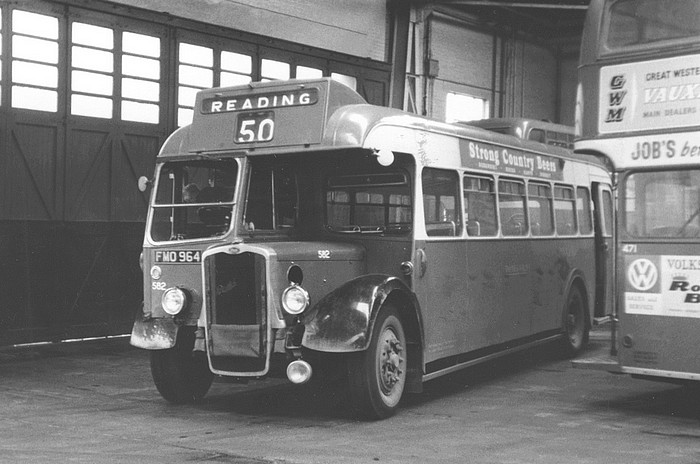
No. 582 (FMO 964) at Reading depot. Photo: unknown.
Built in 1951
Chassis: Bristol LWL6B with 6-cylinder 8-litre Bristol AVW oil engines.
Body: Eastern Coach Works (ECW) 30 feet long, 8 feet wide, B39R.
- 577 (FMO 959) c/n 83272, deliv.1951. Withdrawn 1962 and sold to Marino Coaches, Ferryhill.
- 578 (FMO 960) c/n 83273, deliv.1951. Withdrawn 1962
- 579 (FMO 961) c/n 83274, deliv.1951. Withdrawn 1962
- 580 (FMO 962) c/n 85014, deliv.1951. Withdrawn 1962 and sold to Scarlet Band, West Cornforth.
- 581 (FMO 963) c/n 85015, deliv.1951. Withdrawn 1962 and sold to Rossmore Bus Co., Sandbanks, Poole (acquired forward door at some time). Still with them 1964.
- 582 (FMO 964) c/n 85016, deliv.1951. Withdrawn 1966.
- 583 (FMO 965) c/n 85017, deliv.1951. Withdrawn 1962.
- 584 (FMO 966) c/n 85018, deliv.1951. Withdrawn 1963 and sold to Bedlington and District, Ashington.
- 585 (FMO 967) c/n 85019, deliv.1951. Withdrawn 1962 and sold to Rossmore Bus Co., Sandbanks, Poole.
BRISTOL LWL6B - 607 - 612 (total 6)
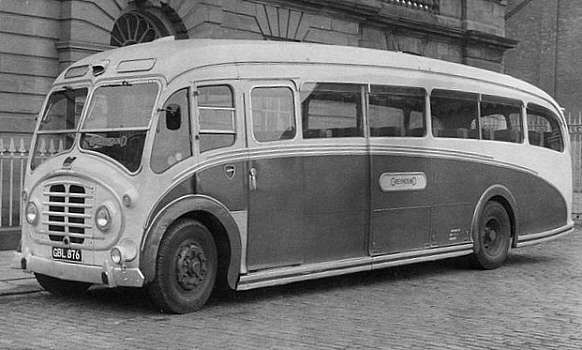
Seen in Dundee in July 1962 is no. 612 immediately after its sale to Alexander (Greyhound). Photo:
George Bett
Built in 1951
Chassis: Bristol LWL6B with 6-cylinder 8-litre Bristol AVW oil engines.
Body: Eastern Coach Works (ECW) 30 feet long, 8 feet wide FC35F (later 37?) coach bodies, painted cream.
- 607 (GBL 871) c/n 85108. Used by South Midland. With T. D. Alexander (Greyhound), Sheffield 1964.
- 608 (GBL 872) c/n 85109. Used by South Midland. Sold 1964 to B. and C. Coaches, Cumnor.
- 609 (GBL 873) c/n 85110. Sold 1964 to Charlton-on-Otmoor Services (Holder). With Royal Free Boys' School, Windsor by 1976.
- 610 (GBL 874) c/n 85111. Used by South Midland. Sold 1964 to Creamline, Borden. When sold, it was the last Bristol L coach in the fleet.
- 611 (GBL 875) c/n 85112. With T. D. Alexander (Greyhound), Sheffield 1964.
- 612 (GBL 876) c/n 85113. Withdrawn 1962 and sold to T. D. Alexander (Greyhound), Arbroath.
BRISTOL LWL6B - 613 - 633 (total 21)
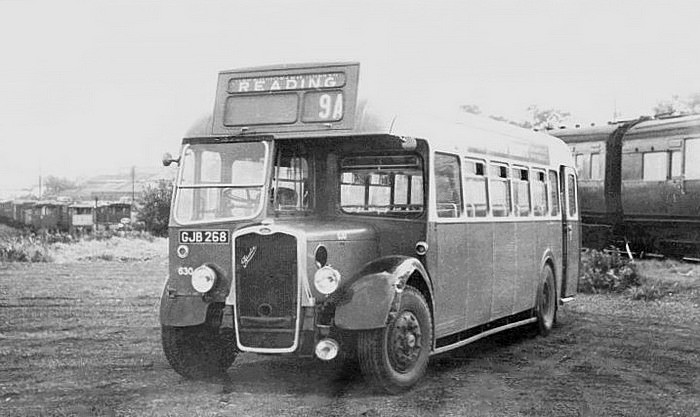
Thames Valley 630 (GJB 268). Photo from the collection of the late Eric Sieler.
Built in 1952 (except 613 and 614 which were built in 1951).
Chassis: Bristol LWL6B with 6-cylinder Bristol AVW oil engines.
Body: Eastern Coach Works (ECW) 30 feet long, 8 feet wide B39R.
Notes: Five of those still in service in 1969 were renumbered in a 2xx series.
- 613 (GJB 251) c/n 85042, b/n 5360, deliv.1951. Withdrawn 1968.
- 614 (GJB 252) c/n 85043, deliv.1951. Withdrawn 1965 and sold to Rossmore Bus Co., Sandbanks, Poole.
- 615 (GJB 253) c/n 85167, deliv.1952. Withdrawn 1968 and sold to Alexander (Greyhound), Sheffield.
- 616 (GJB 254) c/n 85168, b/n 5363, deliv.1952. Withdrawn in 1965 and converted to a supervisors' office, parked at Maidenhead coach station. Became a training bus in 1966 painted all red. Sold in 1971 to Coal Porters Rowing Club, Southampton (converted to carry boats on its roof) ** SURVIVOR ** 616 Preservation Group, Luton 2010.
- 617 (GJB 255) c/n 85169, deliv.1952. Withdrawn 1965 and sold to Alexander (Greyhound), Sheffield.
- 618 (GJB 256) c/n 85170, deliv.1952. Withdrawn 1965 and sold to Alexander (Greyhound), Sheffield.
- 619 (GJB 257) c/n 85184, deliv.1952. Withdrawn 1966 and sold to Bicknell (contractor), Bristol.
- 620 (GJB 258) c/n 85185, deliv.1952. Withdrawn 1969. Owned by Martyrs Memorial Church (Rev.Ian Paisley), Belfast 1971, operated by Magherafelt Presbyterian Church, and still with them in 1973. ** SURVIVOR **.
- 621 (GJB 259) c/n 85186, deliv.1952. Renumbered as 259 in 1969, withdrawn 1970.
- 622 (GJB 260) c/n 87002, deliv.1952. Withdrawn 1965.
- 623 (GJB 261) c/n 87003, deliv.1952. Withdrawn 1964, and acquired by Rossmore, Sandbanks, Dorset.
- 624 (GJB 262) c/n 87015, deliv.1952. Withdrawn 1968
- 625 (GJB 263) c/n 87016, deliv.1952. Renumbered as 263 in 1969, withdrawn 1970.
- 626 (GJB 264) c/n 87017, deliv.1952. Withdrawn 1968 and sold to Elm Park Coaches, Romford. To Cedric Coaches, Wivenhoe, Essex in 1969 to carry Terson staff on British Railways maintenance contract duties.
- 627 (GJB 265) c/n 87018, b/n 5374, deliv.1952. Renumbered as 265 in 1969, withdrawn early 1971 and sold to Royal Free School, Windsor. ** SURVIVOR ** Bilbe, Graham Green and Richard Rampton, Reading 2004.
- 628 (GJB 266) c/n 87019, deliv.1952. Withdrawn 1969 and sold to Sadlar Bros (contractor), Newcastle-upon-Tyne.
- 629 (GJB 267) c/n 87030, deliv.1952. Renumbered as 267 in 1969, withdrawn 1970.
- 630 (GJB 268) c/n 87031, deliv.1952. Withdrawn 1969 and sold to Dowsett (contractor).
- 631 (GJB 269) c/n 87032, deliv.1952. Renumbered as 269 in 1969, withdrawn 1970. picture here.
- 632 (GJB 270) c/n 87054, deliv.1952. Withdrawn 1968 and sold to Drury (contractor), Huddersfield.
- 633 (GJB 271) c/n 87055, deliv.1952. Withdrawn 1968. Sold 1969 to Dew (contractor), Oldham.
BRISTOL L6B - 71 - 74 (total 4)
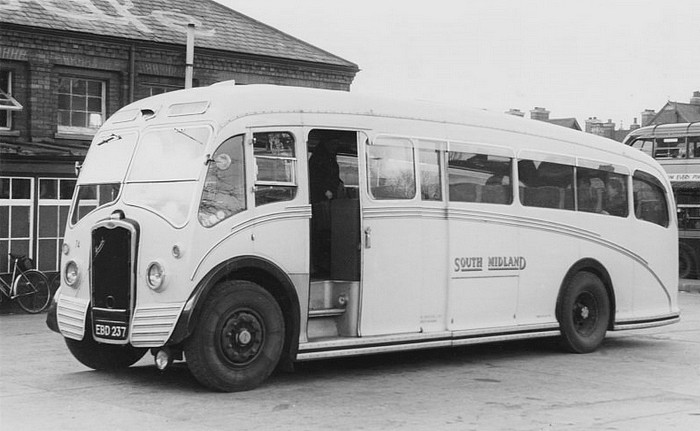
South Midland 74 (EBD 237), formerly United Counties 810, in the ECW body style often known as the
Queen Mary. Photo from the collection of the late Eric Sieler.
Built in 1948 for United Counties
Chassis: Bristol L6B with 6-cylinder 8-litre Bristol AVW oil engines.
Body: Eastern Coach Works (ECW) 30 feet long, 7 feet 6 inches wide C31F, painted cream.
- 71 (EBD 234) c/n 71023, DP31R body. ex United Counties 807 (1948), to South Midland (1952), to Thames Valley (1953). Withdrawn Nov.1959 and sold to Fleet Car Sales, Dunchurch, Rugby. To Jordan, Blaenavon Dec 1960.
- 72 (EBD 235) c/n 71024, DP31R body. ex United Counties 808 (1948), to South Midland (1952), to Thames Valley (1953), converted to B35R (1957). Withdrawn Nov.1959 and sold to Fleet Car Sales, Dunchurch, Rugby. To Jordan, Blaenavon Dec 1960.
- 73 (EBD 236) c/n 73039, FC31F body. ex United Counties 809 (1948), to South Midland (1952) as no. 73. Withdrawn 1961 and sold to Creamline, Bordon.
- 74 (EBD 237) c/n 73042, FC31F body. ex United Counties 810 (1948), to South Midland (1952) as no. 74, Withdrawn Nov 1960 and sold to P.V.D. (dealers) Dunchurch, Rugby, then to Worth, Enstone Dec 1960 (still there in 1962).
BRISTOL LL6B / LWL6B - 75 - 78 (total 4)
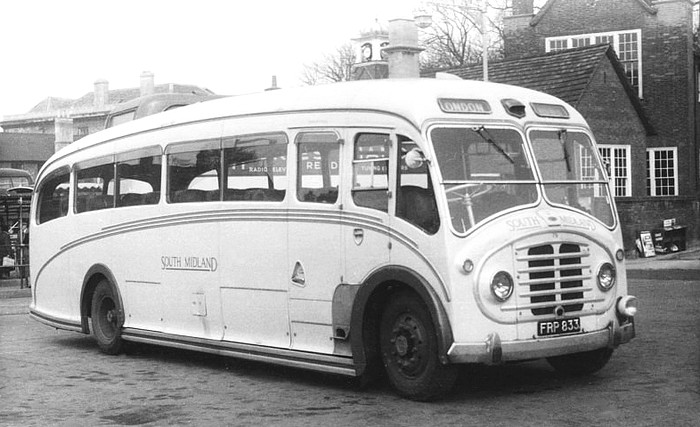
Thames Valley 76 (FRP 833), formerly United Counties 833, in South Midland livery with a 30-foot
coach body and panoramic windows. Photo from the collection of the late Eric Sieler.
Built in 1951 for United Counties, acquired by Thames Valley in 1952.
Chassis: Bristol LL6B or LWL6B with 6-cylinder Bristol AVW oil engines.
Body: Eastern Coach Works (ECW) FC37F.
- 75 (FRP 832) LL6B c/n 83012, ex United Counties 832. Withdrawn 1963 and sold to Leavy and Conlon, Botley, Berks.
- 76 (FRP 833) LL6B c/n 83013, ex United Counties 833. Withdrawn 1963 and sold to B. and C., Cumnor.
- 77 (FRP 834) LWL6B c/n 83068, ex United Counties 834. Withdrawn 1963 and sold to Alexander (Greyhound), Sheffield.
- 78 (FRP 836) LWL6B c/n 83070, ex United Counties 836. Withdrawn 1963 and sold to Creamline, Bordon.
BRISTOL LWL6B - 821 - 829 (total 9)
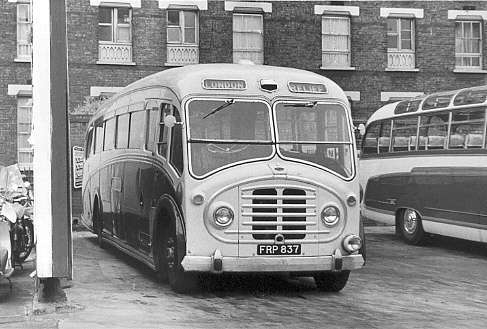
Thames Valley (South Midland) no. 822 at Victoria Coach Station, 26 May 1961. Photo by kind
permission of Nigel Lemon.
Built in 1951 for United Counties, acquired by Thames Valley in 1959.
Chassis: Bristol LWL6B with 6-cylinder Bristol AVW oil engines.
Body: Eastern Coach Works (ECW) 30 foot long FC37F.
Notes: Used under South Midland fleetname, replacing withdrawn AEC Regals.
- 821 (FRP 835) c/n 83069, ex United Counties 835, later renumbered 371. Sold to Thames Valley 1959 as no. 821.
- 822 (FRP 837) c/n 83071, ex United Counties 837, later renumbered 372. Sold to Thames Valley 1959 as no. 822.
- 823 (FRP 838) c/n 83072, ex United Counties 838, later renumbered 373. Sold to Thames Valley 1959 as no. 823. Still active 1963.
- 824 (FRP 839) c/n 83084, ex United Counties 839, later renumbered 374. Sold to Thames Valley 1959 as no. 824.
- 825 (FRP 840) c/n 83085, ex United Counties 840, later renumbered 375. Sold to Thames Valley 1959 as no. 825. picture here.
- 826 (FRP 841) c/n 83087, ex United Counties 841, later renumbered 376. Sold to Thames Valley 1959 as no. 826.
- 827 (FRP 842) c/n 83113, ex United Counties 842, later renumbered 377. Sold to Thames Valley 1959 as no. 827.
- 828 (FRP 843) c/n 83147, ex United Counties 843, later renumbered 378. Sold to Thames Valley 1959 as no. 828.
- 829 (FRP 844) c/n 83148, ex United Counties 844, later renumbered 379. Sold to Thames Valley 1959 as no. 829.
BRISTOL L6A - S301 - S305 (total 5)
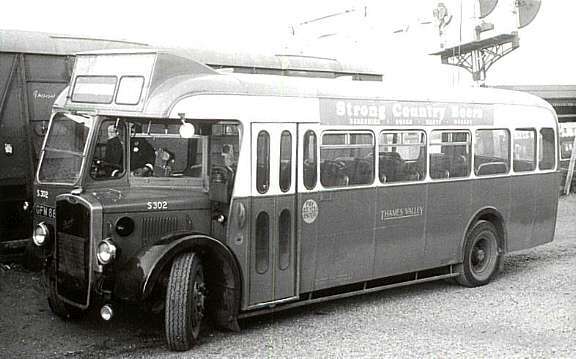
Bristol L6A no. S302 (GFM 882) is seen here during its very short life with Thames Valley in the
early 1960s. It had previously been SLA73 with Crosville but has now been restored to its Thames Valley livery.
Chris Vaughan kindly added more information: Just to confirm that the location of your photo of
S302 (GFM 882) is Reading General station. GFM 882 is parked in the holding area between Reading General station and Reading
Southern, next to the fish dock, a small bay platform at the east end of Reading General's platform 4. At one time the bay was used
for fish traffic but after W.W.2 was used for stabling parcels vans to be attached to westbound trains calling at Reading. The
holding area was not hard surfaced and was pot holed and puddled when it rained. The buses would be stored here before moving out
to Reading General's forecourt to board passengers and depart on service. The date is before 1965. The bay was demolished to make
way for a much longer platform to accommodate Southern electrics from Reading South station which was demolished the same year.
Opposite the location of GFM 882 was a cafe of the taxi driver type and behind GFM 882's location was a corrugated iron hut with a
curved roof (a bit like a large Anderson shelter) which was an oil store for Thames Valley buses. After 1965 the far end of the
holding area became a small car park and a track where GFM 882 is standing was put in so that cars could gain access. The track and
car park was fenced off from the Thames Valley holding area by a fence of horizontal metal poles painted white. Eventually the
whole of the holding area became a car parking when the new Thames Valley bus station was opened in the station approach.
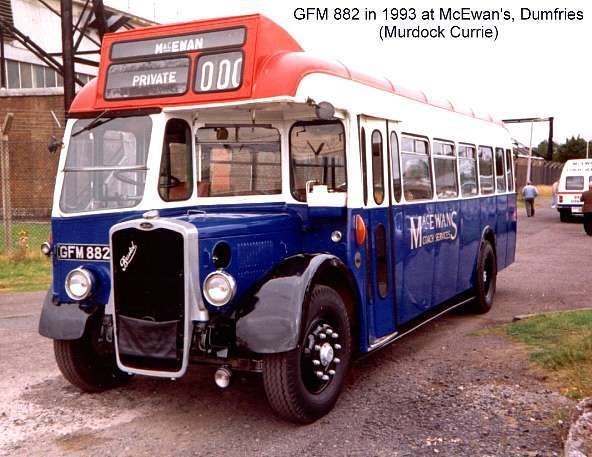
The same vehicle in MacEwan's livery at Dumfries in 1993. Photo by kind permission of Murdock
Currie via Richard McLoughlin. It still survives in preservation.
A picture of it in Crosville livery in 1985 can be seen here.

























